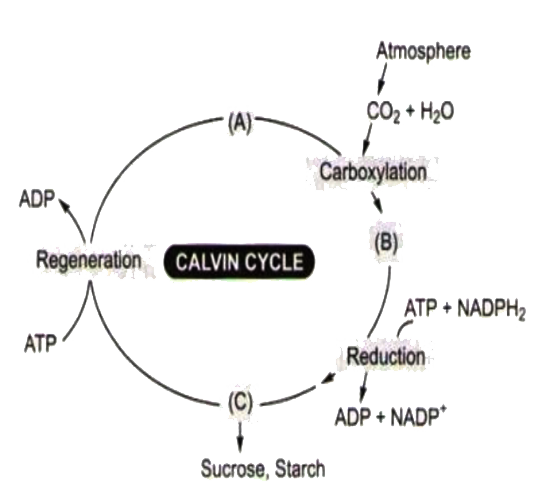Trace the path of carbon in Calvin cycle.
Step-by-Step Solution: Tracing the Path of Carbon in the Calvin Cycle
1. Introduction to the Calvin Cycle:
- The Calvin cycle is a light-independent reaction that occurs in the stroma of chloroplasts. It utilizes the products of the light-dependent reactions, specifically ATP and NADPH, to convert carbon dioxide into organic compounds.
Hint: Remember that the Calvin cycle does not require light directly but depends on the products of the light reactions.
2. Carbon Dioxide Fixation:
- The cycle begins with the fixation of carbon dioxide (CO₂) from the atmosphere. This CO₂ combines with a 5-carbon compound called ribulose 1,5-bisphosphate (RuBP) in the presence of the enzyme Rubisco (ribulose-1,5-bisphosphate carboxylase/oxygenase).
Hint: Focus on the role of Rubisco as the key enzyme that facilitates the initial step of carbon fixation.
3. Formation of 3-Phosphoglycerate:
- The reaction between CO₂ and RuBP produces an unstable 6-carbon intermediate that quickly splits into two molecules of 3-phosphoglycerate (3-PGA), which is a 3-carbon compound.
Hint: Keep track of the number of carbon atoms during each transformation to understand how they are conserved.
4. Conversion to 1,3-Bisphosphoglycerate:
- The 3-PGA molecules undergo phosphorylation by ATP to form 1,3-bisphosphoglycerate (1,3-BPG). This step adds a phosphate group to the 3-carbon molecules.
Hint: ATP is crucial here as it provides the energy needed for the phosphorylation process.
5. Reduction to Glyceraldehyde 3-Phosphate:
- The 1,3-BPG molecules are then reduced by NADPH to form glyceraldehyde 3-phosphate (G3P), another 3-carbon compound. This step is essential as it converts the phosphorylated compound into a sugar precursor.
Hint: Remember that NADPH acts as a reducing agent, facilitating the conversion of 1,3-BPG to G3P.
6. Utilization of G3P:
- Out of the G3P produced, one-sixth of it is used to form glucose or other carbohydrates (like sucrose or starch), while the remaining five-sixths are used to regenerate RuBP.
Hint: Understand the significance of G3P in both energy storage and the regeneration of RuBP.
7. Regeneration of Ribulose 1,5-Bisphosphate:
- The remaining G3P molecules undergo a series of reactions to regenerate RuBP, allowing the cycle to continue. This regeneration process ensures that the cycle can fix more CO₂.
Hint: The regeneration of RuBP is crucial for the continuity of the Calvin cycle, enabling it to process additional CO₂.
8. Conclusion:
- The Calvin cycle effectively converts six molecules of CO₂ into one molecule of glucose through a series of carbon transformations, maintaining the carbon count at each stage.
Hint: Summarize the entire process by noting how carbon is fixed, transformed, and ultimately utilized in the formation of glucose.
- The Calvin cycle is a light-independent reaction that occurs in the stroma of chloroplasts. It utilizes the products of the light-dependent reactions, specifically ATP and NADPH, to convert carbon dioxide into organic compounds.
- The cycle begins with the fixation of carbon dioxide (CO₂) from the atmosphere. This CO₂ combines with a 5-carbon compound called ribulose 1,5-bisphosphate (RuBP) in the presence of the enzyme Rubisco (ribulose-1,5-bisphosphate carboxylase/oxygenase).
- The reaction between CO₂ and RuBP produces an unstable 6-carbon intermediate that quickly splits into two molecules of 3-phosphoglycerate (3-PGA), which is a 3-carbon compound.
- The 3-PGA molecules undergo phosphorylation by ATP to form 1,3-bisphosphoglycerate (1,3-BPG). This step adds a phosphate group to the 3-carbon molecules.
- The 1,3-BPG molecules are then reduced by NADPH to form glyceraldehyde 3-phosphate (G3P), another 3-carbon compound. This step is essential as it converts the phosphorylated compound into a sugar precursor.
- Out of the G3P produced, one-sixth of it is used to form glucose or other carbohydrates (like sucrose or starch), while the remaining five-sixths are used to regenerate RuBP.
- The remaining G3P molecules undergo a series of reactions to regenerate RuBP, allowing the cycle to continue. This regeneration process ensures that the cycle can fix more CO₂.
- The Calvin cycle effectively converts six molecules of CO₂ into one molecule of glucose through a series of carbon transformations, maintaining the carbon count at each stage.
Topper's Solved these Questions
- PHOTOSYNTHESIS IN HIGHER PLANTS BOOK - ICSECHAPTER - PHOTOSYNTHESIS IN HIGHER PLANTS EXERCISE - REVIEW QUESTIONS (MISCELLANEOUS QUESTIONS WITH ANSWERS)
8 Videos
- PHOTOSYNTHESIS IN HIGHER PLANTS BOOK - ICSECHAPTER - PHOTOSYNTHESIS IN HIGHER PLANTS EXERCISE - REVIEW QUESTIONS (QUESTION BASED ON EXPERIMENTS)
7 Videos
- PHOTOSYNTHESIS IN HIGHER PLANTS BOOK - ICSECHAPTER - PHOTOSYNTHESIS IN HIGHER PLANTS EXERCISE - REVIEW QUESTIONS (SHORT ANSWER TYPE QUESTIONS)
19 Videos
- PHOTOMORPHOGENESIS IN PLANTSBOOK - ICSECHAPTER - PHOTOMORPHOGENESIS IN PLANTSEXERCISE - REVIEW QUESTIONS (LONG ANSWER TYPE QUESTIONS)
6 Videos
- PLANT GROWTH AND DEVELOPMENTBOOK - ICSECHAPTER - PLANT GROWTH AND DEVELOPMENTEXERCISE - NCERT EXERCISES WITH ANSWERS (DIFFERENTIATE BETWEEN)
11 Videos
Similar Questions
Knowledge Check
The first acceptor of CO2 in Calvin cycle is
APGABRuBPCPGALDRuPRead the given statements and selct the correct option.
Statement 1: Photorespiration interferes with the successful functioning of Calvin cycle.
Statement 2: Photorespiration oxidises ribulose-1,5 biphosphate which is an acceptor of CO2 in Calvin cycle.ABoth statement 1 and 2 are correct.BStatement 1 is correct but statement 2 is incorrect.CStatement 1 is incorrect but statement 2 is correctDBoth statements 1 and 2 are incorrect.
Isotopes popularly know to have been used in the study of photosynthesis are
or
Which of the following isotope of carbon was by Calvin to trace the path of carbon in photosynthesis
View SolutionScientist awarded Nobel Prize in 1960 for tracing the path of carbon in photosynthesis was
View SolutionCalvin used algae in his experiment for tracing out the path of carbon. The algae used were
View SolutionThe four carbon compound formed during the regeneration of RUBP in Calvin cycle
View SolutionChoose the correct combination of labels for the molecules involved in Calvin cycle.

View SolutionWhich is not a step in Calvin cycle ?
View Solution
